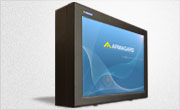The Four Aspects to Protecting Outdoor Digital Signage
Posted by: Richard Williams | Posted on: | 0 Comments
Outdoor digital signage can provide real advantages over indoor digital advertising and the use of other outdoor media. Outdoor screens will receive far higher viewership than an indoor screen and will be far more noticeable and engaging than other traditional outdoor static adverts.
The advantages of outdoor digital signage, however, have to be weighed up against the challenges and for placing a screen in an outdoor location there are four main challenges that have to be overcome:
Weather
One of the most obvious challenges for installing an outdoor screen is the weather. Ensuring the screen is waterproof and protected from rainfall and other weather elements is essential otherwise the screen will soon fail.
In Europe any outdoor digital signage enclosure should adhere to the IP65 standard to ensure it has been designed for outdoor use. In the USA a similar standard is used known as NEMA 4.
Temperature
Another obvious challenge with outdoor screen use is the ambient temperature. LCD screens are designed for a particular temperature range and temperatures exceeding either limit will cause the screen to fail.
Obviously, with seasonal changes this needs to be looked at carefully as sub zero temperatures in winter and the baking heat of summer could both fall outside this optimum range. The key to temperature control usually lies within the LCD or digital signage enclosure where cooling fans and other climatic components ensure the correct temperature inside.
Sunlight
Perhaps one of the most important factors in using an outdoor screen is coping with sunlight. There are two main problems caused by the sun – the first is sun glare when the sun is reflected off the screen causing it to dazzle and become unreadable. The other problem caused by the sun is brightness. In general, the brighter the sun is, the less bright a screen will appear, making it look washed out and unreadable; this is why most LCD screens used outdoors are of a high brightness variety to ensure they counter the sun’s brightness.
Physical
Another consideration that is often overlooked is the need to protect outdoor digital signage from physical impacts and vandalism. Often this protection falls to the digital signage or LCD enclosure too. Commonly these enclosures are manufactured from steel to ensure strength whilst often the screens fitted to them have anti-shatter attributes to prevent damage.
Post shortlink:
Popular Products
LCD Enclosure
Need armor for your LCD/LED screen(s)? Outdoors or inside the versatile LCD enclosure protects against thieves, vandals & the weather. Installation idea: NFL stadiums.
Outdoor Digital Signage
Exclusive 46” outdoor screen protection. Dubbed the ‘Totem’, due to its distinct design, it repels damage threats, but attracts audiences. Installation idea: Drive-thru restaurants.
Portrait Flat Panel Enclosure
Safeguard your eye-level advertising display screen(s), indoors or outdoors. Completely customizable, add exciting features like touch screen technology. Installation idea: Restaurant frontages.
Indoor Digital Signage
Popular purchase for retail outlets! Great for ‘point of sale’ persuasion, boost your brand with static & motion advertising from a single unit! Installation idea: Mall of America.





